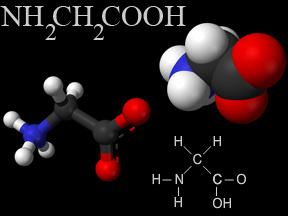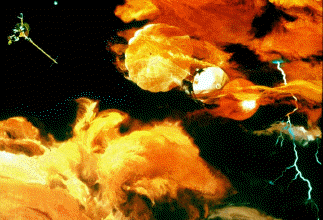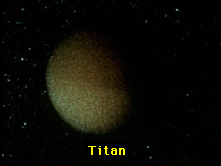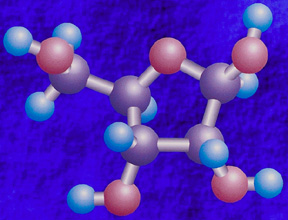Complex molecules such as the one pictured here came together to form coacervates
Click on image for full size
Corel Photography
Coacervates
In the warm primordial ocean, aggregates of amino acids, proteins, and other hydrocarbons coalesced into a form called
*coacervates*. Organic polymers such as amino acids will spontaneously form coacervates in the same way that beads of vinegar in oil coalesce together. The
Miller-Urey experiment showed that amino acids form under conditions similar to the
Earth's primordial environment.
These beads, or coacervates are perhaps the simplest of systems that, without a membrane, can be said to be bound together; that is they have a distinct inside and outside. An ocean provides an ideal substrate for their formation, for the primordial ocean was large, and water can hold the coacervates suspended, allowing them to be undisturbed, for a long period of time.
It is not known whether these coacervates were life-like or not. Recall that life must be able to feed and reproduce itself.
The earliest life was probably much like coacervates, and scientists think that this earliest life probably was chemo-heterotrophic, meaning that they used a chemical process called enzymatic catalysis to process naturally produced organic compounds from the early ocean for food.
You might also be interested in:

The first beings were probably much like coacervates. As a group, these bacteria are called heterotrophic anaerobes. Because there was virtually no oxygen in the atmosphere at this time, these bacteria
...more
In August 2009, scientists reported finding a type of amino acid in a sample returned from a comet. Amino acids are the building-blocks of proteins, one of the key molecules in living creatures. The comet
...more
Jupiter's atmospheric environment is one of strong gravity, high pressure, strong winds, from 225 miles per hour to 1000 miles per hour, and cold temperatures of -270 degrees to +32 degrees (freezing temperature).
...more
In July, 1996, it was announced that Dr. David McKay, along with a team of scientists at Johnson Space Center (a division of NASA), had discovered possible fossils of bacteria in an ancient rock from Mars.
...more
Saturn's atmospheric environment is one of strong gravity, high pressure, strong winds, from 225 miles per hour to 1000 miles per hour, and cold temperatures of -270 degrees to +80 degrees. With winds
...more
Titan's atmosphere is a lot like the Earth's, except that it is very cold, from -330 degrees to -290 degrees! Like the Earth, there is a lot of Nitrogen and other complex molecules. There also may be an
...more
Autotrophs are organisms that produce organic compounds from an inorganic source of carbon (carbon dioxide) given a source of energy. If the source of energy is the reactions of inorganic chemical compounds,
...more















